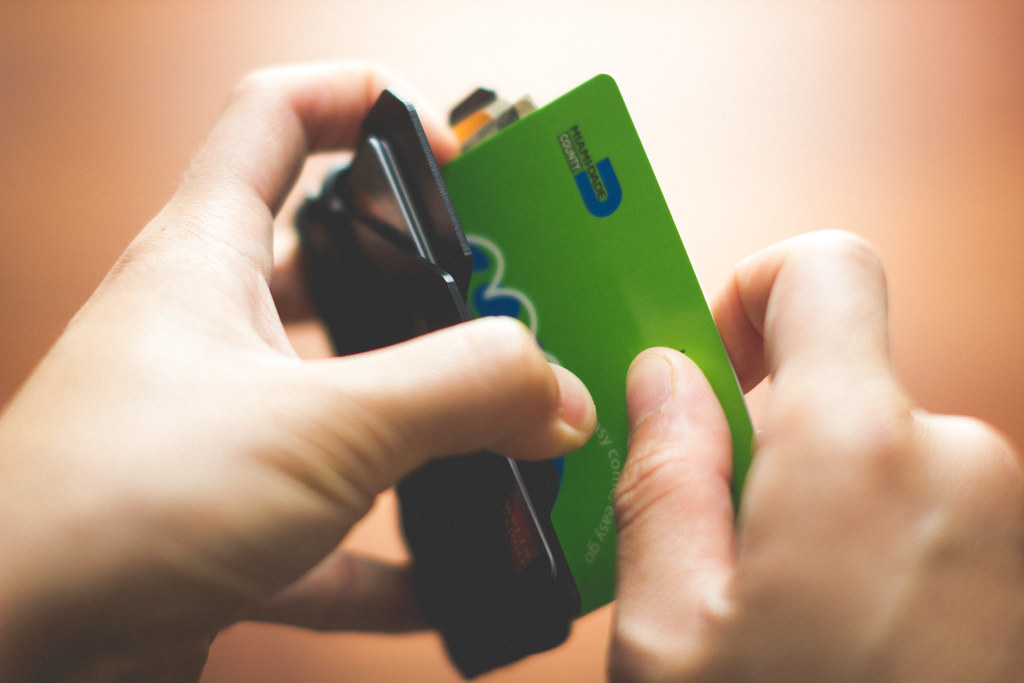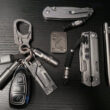OBSTRUCTURES A3 Wallet Review & Giveaway
It seems every week or so, a new minimalist wallet pops up on the market. However, few wallets even come close to resembling the OBSTRUCTURES A3 aluminum wallet with its 3-plate, rolling O-ring design. It looks promising in theory, but how does it handle? Read more for my hands-on review of the A3 and for your chance to win an A3 or A2 wallet courtesy of OBSTRUCTURES.
Upon first glance, the A3 doesn’t immediately present itself as a wallet. Even with a few cards and some cash inside, calling it a wallet feels like a misnomer. Rather, it’s a unique assembly of three, well-machined aluminum plates held together by two large rubber bands (O-rings) merely being used in the way a wallet would be. The smaller, outermost triangular plate serves as an easy-access “pocket” for frequently used cards, while its central cutout doubles as a bottle opener. The two larger plates house your remaining cards, bifolded cash, and other essentials. They’re cut asymmetrically to provide “tabs” to more easily grip and index the wallet, which is crucial to its operation. The plate system is highly modular — optional spare parts let you build a wallet that fits to your preferences. All in all, an empty wallet weighs in at 2.7 oz, which is actually still hefty for a wallet, even compared to bulkier leather wallets it’s meant to replace. It’s also not the most compact, as the main plates are larger than a standard credit card. The black hardcoat plates are smooth to the touch and hide wear and scratches fairly well. The lines are clean, but its hard edges can be slightly uncomfortable when handling the wallet.
The concept of the wallet is unconventional in theory, yet simple enough. The large O-rings clamp the plates together tightly, sandwiching cards and cash in place. To open the wallet, spread the plates apart like opening a book to roll the upper O-ring down and access the wallet’s contents. Cards, bifolded cash and other essentials sit between the plates at the “spine” created from opening the wallet. The O-rings snap the wallet shut when not in use, and rolling the O-ring back up locks the wallet nice and tight.

Unfortunately, I found that in practice, using the wallet is not as easy as I’d have liked — almost frustratingly so. During my initial testing, the O-rings were still very tight, making opening the wallet difficult and uncomfortable. The best solution to this was to roll the O-ring down manually, but that was an extra, inconvenient step I had to take when I wanted to access my cash quickly. Opening the wallet in a rush proved similarly difficult. The resistance on the O-rings just make handling needlessly unintuitive. It’s understandable because of how drastically different the A3’s design is, but in a minimalist wallet, I expect and embrace less material, less weight, fewer moving parts, and lack of organization — but only when resulting in simplicity and efficiency. I became frustrated with needing to properly index the plates’ asymmetric tabs to keep the wallet open. Otherwise, I felt like I was fighting the resistance in the bands to keep it open, often resorting to holding the wallet against my stomach for more support to keep the wallet from snapping out from between my thumbs and fingers, already white from the amount of pressure I had to use to keep it open. Furthermore, the lack of any real “bottom” to the wallet also caused issues with storing and retrieving cards — they would sometimes slide “past” the wallet or sit inconsistently not flush with other cards. This was exacerbated by my lack of control of the wallet when trying to keep it open. Even when I got the hang of operating the wallet per OBSTRUCTURES’s very useful instructional video, I had still had to navigate cards and cash around my fingers holding the wallet open. It just felt like a hassle to receive my change at the register and need to step aside to focus on stuffing it into the A3. When I showed the wallet to my coworkers and let them try slipping a card into it for the first time, they also needed to brace the wallet against their body for more support — it was unintuitive to them as well.

I carried the A3 like a traditional front pocket wallet, and even in the pocket I found the O-rings to be bothersome. They add thickness to the plates and their rubbery grip makes slipping the wallet in and out of the pocket more difficult. Provided you can overcome the learning curve and realize that it’s not a conventional wallet in the slightest, the A3 can really be a perfect wallet for some users. It’s still very sturdy and looks very slick. Grabbing and stashing cards and cash can be a snap with good muscle memory and lots of breaking in the O-ring. I just found that in my experience, the A3 didn’t work well for my smaller hands and smaller pockets.
Reviewer Score: ★★½ out of 5
Pros:
- Sturdy, slim construction compared to conventional wallets
- Accommodates bi-folded cash (rare for minimal wallet)
- Bottle opener and RFID blocking
- Outer “pockets” easily accessible and quick to close
Cons:
- Uncomfortable and unintuitive to operate initially
- Hit-or-miss O-ring system
- Fairly heavy even compared to bulkier leather wallets
- Limited organization
- Metal plates can scratch other essentials, rubber O-rings impede retrieval
The A3 challenges wallet conventions in its design, construction and operation. Unfortunately, I found its learning curve to be challenging as well. It takes some breaking in of the wallet and practice to make the operation of this wallet reasonably convenient. I expect this wallet to not “click” with many users, but for others, can be their holy grail of EDC wallets. Fortunately, OBSTRUCTURES offers different sizes and configurations of their plate/ring wallets, and their standard offerings are fairly affordable. You can grab one at their store, linked below, or enter to win an A3 or A2 courtesy of Matt Hall of OBSTRUCTURES in the contest widget below. Good luck and carry on!









